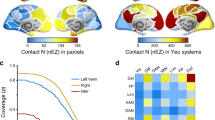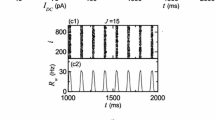Abstract
Oscillations of large populations of neurons are thought to be important in the normal functioning of the brain. We have used phase response curve (PRC) methods to characterize the dynamics of single neurons and predict population dynamics. Our past experimental work was limited to special circumstances (e.g., 2-cell networks of periodically firing neurons). Here, we explore the feasibility of extending our methods to predict the synchronization properties of stellate cells (SCs) in the rat entorhinal cortex under broader conditions. In particular, we test the hypothesis that PRCs in SCs scale linearly with changes in synaptic amplitude, and measure how well responses to Poisson process-driven inputs can be predicted in terms of PRCs. Although we see nonlinear responses to excitatory and inhibitory inputs, we find that models based on weak coupling account for scaling and Poisson process-driven inputs reasonably accurately.
Similar content being viewed by others
References
Acker CD, Kopell N, White JA (2003) Synchronization of strongly coupled excitatory neurons: Relating network behavior to biophysics. J. Comput. Neurosci. 15: 71–90.
Alonso A, Llina’s RR (1989) Subthreshold Na+-dependent theta-like rhythmicity in stellate cells of entorhinal cortex layer II. Nature 342: 175–177.
Alonso A, Klink R (1993) Differential electroresponsiveness of stellate and pyramidal-like cells of medial entorhinal cortex layer II. J. Neurophysiol. 70: 128–143.
Berretta N, Jones RS (1996) A comparison of spontaneous EPSCs in layer II and layer IV-V neurons of the rat entorhinal cortex in vitro. J. Neurophysiol. 76: 1089–1100.
Bland BH, Colom LV (1993) Extrinsic and intrinsic properties underlying oscillation and synchrony in limbic cortex. Progress In Neurobiology 41: 157–208.
Canavier CC, Butera RJ, Dror RO, Baxter DA, Clark JW, Byrne JH (1997) Phase response characteristics of model neurons determine which patterns are expressed in a ring circuit model of gait generation. Biol. Cybern. 77: 367–380.
Charpak S, Pare D, Llinas R (1995) The entorhinal cortex entrains fast CA1 hippocampal oscillations in the anaesthetized guinea-pig: Role of the monosynaptic component of the perforant path. Eur. J. Neurosci. 7: 1548–1557.
Chow CC, White JA, Ritt J, Kopell N (1998) Frequency control in synchronized networks of inhibitory neurons. J. Comput. Neurosci. 5: 407–420.
Chrobak JJ, Buzsa’ki G (1998) Gamma oscillations in the entorhinal cortex of the freely behaving rat. J. Neurosci. 18: 388–398.
Demir SS, Butera RJ, Jr., DeFranceschi AA, Clark JW, Jr., Byrne JH (1997) Phase sensitivity and entrainment in a modeled bursting neuron. Biophys. J. 72: 579–594.
Dorval AD, Christini DJ, White JA (2001) Real-Time linux dynamic clamp: A fast and flexible way to construct virtual ion channels in living cells. Ann. Biomed. Eng. 29: 897–907.
Ermentrout B (1996) Type I membranes, phase resetting curves, and synchrony. Neural. Comput. 8: 979–1001.
Fries P, Roelfsema PR, Engel AK, Konig P, Singer W (1997) Synchronization of oscillatory responses in visual cortex correlates with perception in interocular rivalry. Proc. Natl. Acad. Sci. USA 94: 12699–12704.
Gray CM, Konig P, Engel AK, Singer W (1989) Oscillatory responses in cat visual cortex exhibit inter-columnar synchronization which reflects global stimulus properties. Nature 338: 334– 337.
Hansel D, Mato G, Meunier C (1995) Synchrony in excitatory neural networks. Neural. Comput. 7: 307–337.
Kopell N, Ermentrout GB (2002) Mechanisms of phase-locking and frequency control in pairs of coupled neural oscillators. In: B Fiedler, ed. Handbook on Dynamical Systems. Elsevier, New York, pp. 3–54.
Netoff TI, Banks MI, Dorval AD, Acker CD, Haas JS, Kopell N, White JA (2005) Synchronization in Hybrid Neuronal Networks of the Hippocampal Formation. J. Neurophysiol. (in press).
O’Keefe J (1993) Hippocampus, theta, and spatial memory. Current Opinion in Neurobiology 3: 917–924.
Oprisan SA, Canavier CC (2001) Stability analysis of rings of pulse-coupled oscillators: The effect of phase-resetting in the second cycle after the pulse is important at synchrony and for long pulses. Differential Equations and Dynamical Systems 9: 243–258.
Oprisan SA, Canavier CC (2002) The influence of limit cycle topology on the phase resetting curve. Neural. Comput. 14: 1027–1057.
Oprisan SA, Thirumalai V, Canavier CC (2003) Dynamics from a time series: Can we extract the phase resetting curve from a time series? Biophys. J. 84: 2919–2928.
Oprisan SA, Prinz AA, Canavier CC (2004) Phase resetting and phase locking in hybrid circuits of one model and one biological neuron. Biophys. J. 87: 2283–2298.
Press WH, Teukolsky SA, Vetterling WT, Flannery BP (1992) Numerical recipes in C: The Art of Scientific Computing, 2nd edition. Cambridge University Press, Cambridge [Cambridgeshire], New York.
Reyes AD, Fetz EE (1993) Two modes of interspike interval shortening by brief transient depolarizations in cat neocortical neurons. J. Neurophysiol. 69: 1661–1672.
Roelfsema PR, Engel AK, Konig P, Singer W (1997) Visuomotor integration is associated with zero time-lag synchronization among cortical areas. Nature 385: 157–161.
Singer W (1999) Neurobiology. Striving for coherence [news; comment]. Nature 397: 391, 393.
Skaggs WE, McNaughton BL, Wilson MA, Barnes CA (1996) Theta phase precession in hippocampal neuronal populations and the compression of temporal sequences. Hippocampus 6: 149–172.
Squire LR, Zola-Morgan S (1991) The medial temporal lobe memory system. Science 253: 1380–1386.
Stewart M, Fox SE (1990) Do septal neurons pace the hippocampal theta rhythm? Trends Neurosci. 13: 163–168.
Van Vreeswijk C, Abbott LF, Ermentrout GB (1994) When inhibition not excitation synchronizes neural firing. J. Comput. Neurosci. 1: 313–321.
Winson J (1978) Loss of hippocampal theta rhythm results in spatial memory deficit in the rat. Science 201: 160–163.
Author information
Authors and Affiliations
Corresponding author
Rights and permissions
About this article
Cite this article
Netoff, T.I., Acker, C.D., Bettencourt, J.C. et al. Beyond Two-Cell Networks: Experimental Measurement of Neuronal Responses to Multiple Synaptic Inputs. J Comput Neurosci 18, 287–295 (2005). https://doi.org/10.1007/s10827-005-0336-9
Received:
Revised:
Accepted:
Issue Date:
DOI: https://doi.org/10.1007/s10827-005-0336-9




